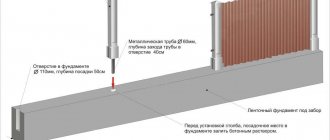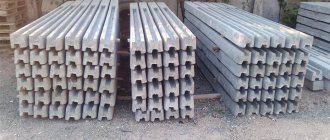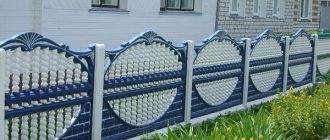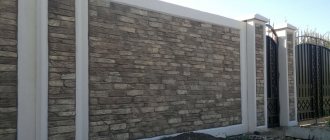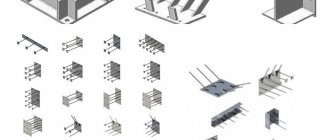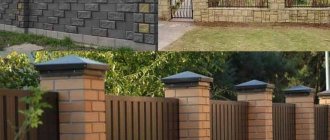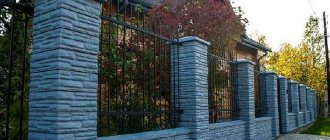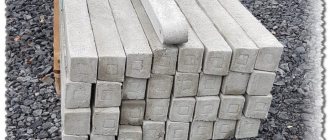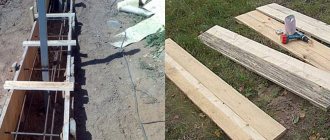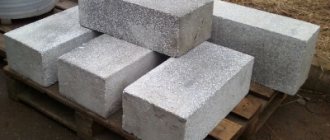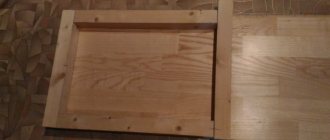Concrete blocks as a fence have won well-deserved recognition due to their high performance characteristics and beautiful appearance. They are presented in a wide range and can imitate both a smooth plastered wall and an uneven texture like torn stone. The color scheme of fencing blocks can be almost any.
Example of fence posts made of concrete blocks
Such a fence is a beautiful and reliable solution, and decorative concrete posts can be used on their own, in combination with other fencing materials.
Causes of destruction
Sketch of the correct design of the structure
Often we can see destroyed fences that seemed to have such a strong structure. The whole trouble most often begins with the supporting elements. The supporting part of the fence can collapse for several reasons:
- non-compliance with installation rules, for example, small depth;
- the design of the support element pit does not correspond to the characteristics of the soil;
- the use of low-quality material in the manufacture of a product or in the construction of a foundation.
All such shortcomings will reveal themselves after the first wintering of the structure, so you shouldn’t take risks. It is better to consult with specialists, play it safe several times, than later be disappointed in the fencing structure and regret the money wasted.
Well, if all the work was done efficiently, in compliance with all standards and rules, then such a fencing structure will last for decades, especially if it is provided with decent care.
Problems with heavy fences
Fencing problems often begin due to non-compliance with masonry rules. You can often see a cinder block fence with a vertical crack, or loose sandblock fence posts, or rickety Besser fences. It is unlikely that anyone wanted to build fences in order to face such troubles in a couple of years. To avoid such consequences, attention should be paid to laying the foundation and installing pillars.
Schematic representation of block masonry options
A diagonal crack in a structure can occur if the foundation is not deepened correctly, that is, less than required by standards, especially if cinder block fences were installed on clay soil.
Loads from the ground on frosty days are uneven, because these are natural formations; on the other hand, there is a load from the cinder block structure itself or the fence blocks, which are also absolutely uneven. As a result, the foundation begins to walk. This is why cinder block fences crack or the structure of a sand block fence tilts, and the even, chic shapes of the fence take on a poor appearance.
Remember! Fences whose height exceeds 1 meter must stand on a solid foundation with a depth not less than the freezing depth.
Before pouring the foundation, it should be strengthened with reinforcing bars or rods. It will be possible to build heavy fences only after the foundation is stable. This will take at least a week. While the foundation is hardening, it should be periodically moistened, especially in hot weather, to prevent cracks from appearing on its surface. Only after such manipulations with the foundation will the structure not crack and last for an extremely long time.
Whatever the shape of the fence blocks, the posts for them must be installed in accordance with all standards. Try to use the level as often as possible. The more accurately and firmly the posts are installed, the longer the fence will serve you. Fence blocks must be strictly laid level; any deviations can ruin the entire structure, even if the shapes of the fence blocks are geometrically correct and absolutely small.
Popular manufacturers, pole prices
Among the domestic companies it is worth highlighting the following:
- LLC "Pokrovsky Reinforced Concrete Products Plant" Operating since 1970. Produces reinforced concrete products for residential and industrial construction, including elements for fencing.
- LLC "Ochakovsky Concrete Concrete Plant" or Moscow Reinforced Concrete Plant. Leader in the production and trade of concrete products of varying complexity throughout the Moscow region. The product list includes paving slabs, paving stones, curbs, posts, fencing elements and more. For regular customers, it is possible to manufacture products in the sizes they need.
- OJSC "Domodedovo Concrete Concrete Plant" Operating for over 50 years. The products of this company are in demand not only in Russia, but also far beyond its borders. The plant produces concrete elements for panel houses, blocks, borders, pillars, and slabs for fences.
Prices from domestic manufacturers are approximately in the same range, so here are the average figures:
- Concrete block size 30*30 cm, height 20 cm – 400–600 rubles. A foundation block of these dimensions costs from 360 rubles.
- Cover for a post without decoration – from 350 RUR/piece, with decoration – from 500 RUR/piece.
- A finished one-sided concrete pillar with dimensions of 290*15*13 cm - from 1300 rubles, double-sided of the same dimensions - 1700 rubles. In this case, the height of the above-ground part in both cases is 2 m.
If you buy textured supports, their price will be 30-40% higher than regular ones.
If the owners are not afraid of the laboriousness of making poles themselves in conditions of limited resources, they can make the poles themselves. If there is little time for construction, it is better to buy ready-made supports.
More about plastic
One of the materials used in the manufacture of fence forms is worth special attention - this is plastic.
Advantages
When we talk about plastic, we mean the following invaluable advantages:
Greater strength is thanks to modern production technologies, although initially, it was precisely problems with strength that did not allow plastic to enter the wide “construction” road.
Cheapness. Where there is plastic, there is casting, which means ready-made and mass-produced technologies
This is especially important for the production of fences. when the forms for fence posts and the spans between them already form a single whole, which directly comes out of the press in production.
The shapes of the fences seem to be specially made for use on industrial sites, where the speed of construction comes to the fore, although the design side of the matter is not forgotten
- Ease. which does not at all contradict reliability. But the installation speed increases by an order of magnitude.
- Extreme resistance to negative environmental influences. This feature of modern plastic has been tested in pipes and does not need any proof.
- Huge selection of design solutions. This is also the merit of the very process of producing plastic structures - casting, which is accompanied by the addition of all kinds of additives and dyes, creating an incredible range of colors at the output.
Disadvantages of plastic
Strictly speaking, plastic fence structures have no disadvantages.
More precisely, their advantages are also a continuation of their disadvantages (although, rather, on the contrary).
Ease. But, firstly, plastic is often framed in a rigid metal case, and, secondly, the concept of lightness is very relative for a panel measuring 3 by 2 meters with a thickness of up to 15 cm.
Molds for the production of fences can include all the elements in a single design - then only 2 problems remain to be solved: dimensions and installation
Insufficient reliability. Again, given post structures, any material requires very secure installation of fence posts. The reliability of the entire structure primarily depends on them. But, in addition, no matter what the fence is, it will not withstand the braking of buses on it.
When installing fences in the photo, you cannot do without such a guide as installation instructions; all elements here must be very precisely adjusted to each other
Helpful advice! Installing any fence requires careful attention to post drainage. Keep in mind that the hole for the post should be made 30-40 cm below the freezing level of the soil. If your soil is prone to collecting moisture, so-called heaving, then the best option would be to remove it completely and install the post in a pre-filled mixture of sand and fine gravel. Do not forget to compact this manually prepared soil thoroughly. Drainage must also be carried out at ground level, at a distance of 20-30 cm from the pillar and to a depth of at least 15 cm.
You can even construct a fence from pre-prepared forms. You just need to carefully familiarize yourself with all the options available to you, evaluate all the disadvantages and advantages of each. Be sure to coordinate all proposals with the nature of the soil under your future fence. Most likely, you will entrust the installation of the fence to already experienced craftsmen, but be aware of all the decisions made, then you will not have to regret the choice you made.
It is not necessary that the shape of the fence post must exactly match the shape of its span, the main thing is just to maintain a single style
In the video presented in this article you will find additional information on this topic.
Preparatory work
The installation process can be divided into three stages.
- At the first stage, the material is transported and unloaded.
- During the second stage, the territory is marked.
- The third involves the installation of pillars and blocks. To facilitate installation work during the unloading process, the blocks should be placed along the future fence.
Before building a fence from blocks, the first thing you need to do is mark the area where it is supposed to be installed. This procedure is performed as follows:
- Pegs are driven along the axis of the fence, on which the cord is pulled. It is necessary to determine the central points of the future fence bases and drive pegs in these places.
- The posts should be spaced 205 cm apart.
- To determine the distance between the posts as accurately as possible, you can make a template.
Further work occurs in the following sequence of actions:
- Based on the resulting markings, you need to drill holes in the ground. First of all, holes are made in the corners or at the location of the future wicket and gate.
- Two pillars should be installed in the corners. When working with soils containing unwatered loams, the hole dimensions should be 120 cm in depth and 30 cm in diameter.
- If you are dealing with waterlogged or clayey soil, you need to create a sliding layer using roofing felt and asbestos cement pipes, which will prevent heaving processes.
- During work, you should adhere to the markings as accurately as possible; permissible deviations should not be more than 10 mm.
- Using a level, the posts at the top points need to be leveled according to the markings.
- During the third final stage, the installation of pillars and blocks is carried out. Work on installing pillars should begin from the corner or from the points where the gates and wickets are located.
- After installing the first pillar, the next ones need to be mounted, focusing on the template. It is also necessary to use a plumb line or level to monitor the vertical position of the pillars.
- If during installation the fence needs to be rotated, then two posts are installed in the appropriate place.
- If the installation site is not level, poles of different lengths should be used.
Composition, manufacturing technology
The basis of the products is pure concrete or slag concrete, sand. The remaining components are auxiliary and are added depending on the production method. These include:
- crushed stone;
- medium or fine gravel;
- broken bricks, pieces of concrete;
- expanded clay;
- stone chips;
- broken glass;
- slag.
Broken glass is added to the mixture only for decorative purposes, so that the surface shines in different colors.
They produce solid and hollow blocks.
Solid ones are practically not used for fence structures, since they put a large load on the foundation and have a high price.
To strengthen the structure, the masonry is reinforced, and in the support version, it is placed on top of a metal pillar. Many of them have special grooves, which simplifies installation, which is why another name for blocks is typesetting.
The finished material is obtained in two ways:
- Vibration casting. Forms are installed on a special vibrating table into which liquid concrete solution is poured. The mixture is compacted due to vibration. The block has a smooth surface. The choice of colors is large, but durability and frost resistance are low.
- Vibrocompression. Achieved using semi-dry concrete technology - the ingredients are mixed with a small amount of water. The compaction of the solution is carried out both in the horizontal direction - the platform vibrates, and in the vertical direction - the press works. The surface is rough. The choice of shades is small, but the blocks are highly durable and resistant to temperature changes.
Technological process for manufacturing fence blocks
The raw materials for the production of decorative sections are crushed natural stones. Mixed in the right proportions and placed in molds, they are subjected to vibration and pressure on machines. The components of the mixture for the manufacture of sections are loose aggregates (expanded clay, sand, crushed stone), binding material - cement, dyes, and other additives that improve the properties of concrete.
Vibrocasting
When making blocks for fence posts, the mixture is molded with the addition of water in an amount sufficient to ensure the plasticity and workability of concrete. The forms with the solution are placed on a vibrating table and are not closed; pressing is not performed.
The compaction of the mass occurs due to vibration for several minutes. The block dries in the mold itself, after which the finished product is removed.
READ ALSO: How to Lubricate Fence Forms
Vibration pressing
This method involves preparing a mixture using semi-dry concrete technology: an insufficient amount of water is added to the bulk components to achieve plasticity. The mass is compacted due to two forces: horizontal vibrations of the machine platform and vertical pressure on the mixture from above.
The optimal ratio of components is selected by trial. Finished products are laid out on pallets for natural or forced drying.
Do-it-yourself block production
You can look for raw materials for making concrete sections yourself in the vicinity of the fenced area; these can be sand, gravel, small stone chips, broken bricks. You will have to buy cement and molds.
Preparation of concrete composition
The grade of cement is not lower than M400, the aggregates must be dry and free of debris, the water must be clean. Proportions for preparing a concrete mixture for the manufacture of a decorative block of a type-setting support:
- cement - 1 part;
- sand with fine crushed stone - 2 parts;
- plasticizing additive - 0.3-0.5% by weight of cement, pre-dissolved in water.
The mixture is moist, crumbly and should not spread.
Molds for making fence blocks
The concrete mass is loaded into a matrix that has a contour in the form of a concrete block for the fence. To ensure that there is a cavity inside the mold, a void box, a metal container, is inserted. Matrix materials:
- fiberglass - hard and durable;
- PVC - products made from it are inexpensive and provide good quality;
- polyurethane - allows for the application of complex patterns.
It is better to buy molds rather than try to make them yourself.
Basic recommendations for manufacturing
At home, you should use the vibration pressing method - the blocks for the pillars are more durable. Tips for craftsmen:
- follow the recipe for the concrete mixture, add water gradually, mix thoroughly;
- lubricate the working surfaces of the molds and void box with machine oil before loading;
- compact the filled mass with a wooden block, striking the other end with a hammer;
- remove the hollow core upon completion of pressing and disassemble the mold.
The finished block needs to be dried for at least two days, and it will gain its final strength in 28 days. To obtain the desired color, dyes are added to the concrete solution.
Cinder Block Information
Modern high-quality cinder block for a fence.
The material is obtained by vibrocompression of cement mortar poured into special forms. The filler is sand, gravel, crushed stone screenings, brick production waste and even sawdust. As a result, the quality and characteristics of the blocks will differ .
Advantages of a cinder block fence
- Today the price of 1 standard cinder block 190x190x390 is 30-40 rubles. This is lower than the cost of bricks and other analogues. A colored block with a special chamfer is more expensive - 55 rubles. for 1 block.
- It is extremely simple to erect a cinder block fence, and we do not need any special professional skills for this.
- This fencing is absolutely resistant to frost, does not respond to mechanical shocks, and is not subject to fire.
- The durability of the fence will be more than 50 years.
- In the production of modern blocks, environmentally friendly raw materials are used that are safe for humans and the environment.
- The weight of the fence is also advisable: 1 sq. m. such cinder block masonry is one and a half times lighter than any brick.
By the way, we can make a cinder block ourselves, saving money and giving it the necessary properties by specially adjusting the composition and expanding the components of the solution. And the only disadvantages we consider are its hygroscopicity and poor sound insulation.
Types of blocks and their advantages
Finishing a concrete fence with plaster
The fence made from the blocks in question is easy to install. You don’t have to turn to professionals for help and do all the work yourself.
The advantages of such decorative products include the ability not only to create a solid fence, and thereby completely protect yourself from the prying glances of passers-by, but also to do without finishing it. In addition, such blocks resist open fire well, which means they are fireproof.
Solid block fencing
This material is not afraid of either low temperatures or high humidity. The dimensions of the products allow the installation of both a completely concrete fence and a fence consisting of different materials. For example, you can combine the material with wood, corrugated sheets, plastic and other materials.
The positive qualities of fencing made of such material include the following:
- This is a reliable capital structure;
- The decorative nature of the material used allows you to create a wide variety of types of fencing;
- A fence made from expanded clay blocks is strong and durable;
- It is not difficult to build such a fence yourself. It is enough to follow the sequence of work performed;
- Concrete is not afraid of moisture, so it is not susceptible to rotting and mold;
- Fencing made from such blocks can withstand wind loads and other aggressive environmental influences;
- Concrete fencing is fireproof.
Upon completion of the construction of the fence, its surface can be painted in any color.
Hollow decorative block
It is important that this paint is resistant to environmental influences and is intended for painting concrete surfaces. On the modern building materials market there are many different types of material with a decorative surface
Concrete fence blocks
Thanks to this, you can implement any design ideas.
Decorative items
The disadvantages of this building material include its heavy weight. One element has a mass of at least 30 kg, and there are also more massive products.
The structure turns out to be very heavy and therefore requires the creation of a solid foundation. Therefore, it is impossible to do without additional financial costs. But still, such a material has much more positive properties than negative ones.
Blocks for concrete fences
Main characteristics
Fence elements. A standard decorative product has dimensions of 480x320x150. Its surface can be simple, looking at which you can immediately understand that it is concrete.
Some sizes of decorative items
But there is also a material with a surface that imitates crushed stone. This material goes well with spans made of wood, metal, plastic, and PVC.
Product range
Fencing made from decorative blocks fits perfectly into any design. The product is the main element in the design of the support column. In shape it is a rectangular parallelepiped.
Decorative blocks are produced by vibration pressing. Cement acts as the main binder. Often additional components are added to the concrete mixture: crushed stone, gravel, brick.
Some decorative material options
Types of decorative blocks
There are several options for decorative products:
| The hollow block is lightweight. Allows for hidden communications - electrical, alarm, gate automation control. Subject to reinforcement to enhance strength. Their price is lower compared to full-bodied ones. | Solid blocks made of cellular concrete are light in weight and do not exert a serious load on the base. |
| Hollow product | Solid product |
| With one decorative side | With two decorative sides |
| Single-sided decorative products (brick) | Double-sided decorative products |
| Insulated multilayer expanded clay concrete blocks | |
| |
| There are products with grooves designed for better connection with each other. | Stacked hollow block for forming a column with reinforcement inside. |
|
|
No. 3. Decorative concrete slabs
Decorative concrete slabs are produced in a length of 2 m and a height of 55 cm, so the height of the fence can be adjusted at your discretion. As a rule, fences are erected from 2-4 sections stacked on top of each other. Such modules are produced by pouring concrete into molds, the variety of which is quite large. Sections can be blank and openwork, imitate sandstone, slate, brick , tiles , wood, and have various patterns and ornaments. There are even samples where concrete is combined with forged elements and wood. Fences built from such slabs are called Eurofence .
Concrete can be painted after it is cast into a mold, but it is better to choose products painted in the mass - they retain their original appearance much longer and do not scratch or fade. Different decorative concrete slabs can be combined with each other to create exclusive combinations. In addition, slabs with double-sided decorative coating are also produced - they are useful when it is important that the fence looks attractive on both sides.
Higher slabs are also produced, which in themselves are already a full-fledged section of the fence. They are not as diverse in terms of design and color, but still prettier than industrial monolithic sections, and they weigh less.
Monolithic pillars
Making monolithic concrete supports is a simple process. This is an opportunity to create a high-quality base for a fence yourself at minimal cost. The great advantage of a monolithic pillar is the ability to decorate it at your own discretion. The supports can be made of any shape - round, rectangular or square, the main thing is to assemble the appropriate formwork. To create the correct shapes, boards or plywood are suitable; for round supports, a plastic pipe sawn in half.
Installation of a monolithic concrete pillar
- A hole is dug and crushed stone is poured onto the bottom.
- A reinforcement frame welded from longitudinal and transverse rods is installed in the hole. The verticality of the frame is checked by the building level.
- Concrete is poured into the hole and compacted.
The hole is left to harden. Reinforcement of a hole for pouring concrete into a pillar - The formwork is being installed. The reinforcement cage should not come into contact with the formwork, but should be located exactly in the middle.
- The formwork is filled in layers with a cement composition, each layer is bayoneted so that there are no air cavities left. After 3 days, the formwork is removed.
The resulting nondescript concrete pillar will be given a decorative touch by textured plaster, artificial stone or decorative brick.
Decorative stone for fence posts
Artificial stone is widely used for both interior and exterior decoration of buildings, foundations, finishing and cladding of fences and pillars. It is a composition of cement, sand and various additives and coloring pigments. Decorative stone perfectly conveys the texture and beauty of natural minerals and at the same time has a number of additional advantages that distinguish it from natural materials:
Fence trimmed with decorative stone
- Price. Natural stone has a high cost compared to artificial material cast from concrete.
- Ease. Decorative stone has less weight, it is easier to lay it on regular tile adhesive or cement without additional fastening. In addition, the lightweight material does not overload the supports.
- Correct form. Thanks to its straight lines and geometry, artificial stone does not require complex fitting and selection of elements.
- Resistance to negative natural factors. The facing stone is suitable for external work; it is not afraid of moisture, critical temperatures and exposure to ultraviolet radiation.
- Variety of choice. The shape, color and texture of the artificial material can be any.
Types of typesetting blocks and their characteristics
The average weight of one block is from 10 to 25 kg. Length 30–50 cm, width 15–25 cm, height 14–25 mm.
Based on their composition and technical characteristics, they are divided into several types. Let's look at each of them in more detail.
Expanded clay concrete
Expanded clay is called clay that is fired at high temperatures. Thanks to the addition of expanded clay, the weight of the concrete block is reduced.
Photo: To protect expanded clay concrete blocks from moisture, facade paint and polymer compounds (water repellents) are used. To apply paint, use a spray gun.
The choice of colors and textures is small. The surface is often rough. The shape is rectangular.
Decorative
Raw materials - clay, artificial stone, concrete and various fillers.
According to the design features there are:
- with grooves;
- without grooves;
- embossed;
- smooth.
They also produce decorative slabs for fencing, which allows you to quickly assemble modular structures that do not require finishing.
Photo: color scheme of blocks
The surface of such blocks can imitate:
- slate;
- brick;
- tree;
- tiles;
- sandstone.
They are similar in structure and size to gas blocks and foam blocks. The price is affordable. Wide choice of colors.
Thanks to their original appearance and light weight, they have gained popularity not only in the assembly of fences, but also in the construction of houses and gazebos.
Construction
The raw material is pure concrete. They have impressive weight. There are cavities inside. The surface is smooth on top. Color – grey. Due to their unattractive appearance, they are rarely used when constructing fences in the private sector, more often as post material, or for fences at industrial sites.
Cinder blocks
The filler is slag.
Photo: stone obtained by vibration pressing - cinder block.
They are light in weight. Frost-resistant. There are cavities inside.
Concrete
Another name is besser. Depending on the manufacturer, crushed stone, gravel, and screenings are added to the composition. These components strengthen the structure of the blocks, increase strength, and resistance to mechanical damage. Color – gray with shades. They are inexpensive.
Photo: building hollow concrete block
Foam blocks
The composition may be different for each manufacturer.
Popular types are gas silicate and aerated concrete.
The structure can be solid or hollow.
When constructing fence posts, foam blocks are often used. This is due to its low weight and convenient size.
Photo: after installing the fence, care should be taken to protect it from moisture and precipitation. One way is hydrophobic impregnation
Dimensions of the standard block – 20*20*40 cm.
Often they take material whose surface imitates torn stone.
Finished sections and pillars made from blocks can be painted. You can learn more about the procedure and application nuances here: “Painting a concrete fence.”
Splitter
This is a hollow material consisting of two halves.
Photo: hollow blocks without a bottom are made in different colors
With stone chips (washed concrete)
is a manufacturer of concrete blocks and specializes in supplying these products. We also design and build fences from them with the additional provision of design services.
In terms of its operational parameters, this material surpasses the previously highly sought-after brick, which leads to its widespread use and wide demand. Blocks for a concrete fence are made according to the semi-dry vibrocompression method, which requires special forms and mixtures, which include cement with different fillers. The reliability and durability of finished products directly depend on them.
Among the components used:
Such supports can be solid or hollow. Adding fine-grained granite, pebble, and marble chips to the solution allows you to obtain a stone-like surface. The technology is called “washed concrete”. It involves removing the top layer, onto which a hardening retarding gel is first applied. As a result, a chipped texture with inclusions of different sizes appears. Coloring is carried out with pigments of the required color.
Creating forms yourself
However, a person himself is capable of making similar forms. To speed up the process, you will need a multi-position matrix. With its help, you can cast four pillars at a time.
The matrix will require boards with the following parameters:
- 3x 25 x 250 cm (9 pieces);
- 3x 25 x 100 cm (2 pieces).
You will also need the following from the list:
- wood screws,
- a tool for screwing them in (a screwdriver, but a screwdriver is better),
- metal plates (8 pieces),
- sheets of tin,
- used oil,
- concrete composition,
- fittings
The following is a diagram of such a matrix:
The action plan is:
- Six boards 250 cm long and three boards 100 cm long are covered with tin on one side. The three remaining boards are upholstered on both sides.
- The formwork is assembled using screws. Nails are not suitable here, because they are very difficult to remove.
- The matrix is treated with waste oil.
- The reinforcement is tied and laid.
- The concrete composition is poured. He meticulously equalizes the entire form.
- An equal distance is measured on both sides, and metal plates are installed. The frame will be attached to them.
- The matrix is covered with damp burlap. This mold must be wetted for seven days.
Manufacturing nuances
You can make blocks for fence posts yourself. To do this, you need to prepare the appropriate components, as well as forms. As for the components, it all depends on what effect the owner of the fenced area wants to achieve.
Mold for making decorative items
Recipes
There are several versions of the recipes. Most often, the mixture is made from Portland cement and pure sand in a ratio of 1:2.
Superplasticizer Poliplast SP-1
To reduce cement consumption, you can add fine gravel to the mixture, and in order for the material to look like natural stone, you can use marble chips or glass as texture substances when making a block.
Concrete fillers
Anyone who wants to have a fence in their dacha that is not monotonous gray, but some other color that is brighter, can add coloring pigments to the mixture.
Products painted with pigments for concrete
In order to make a block of the required size from the prepared mixture, you will need molds.
Mold for making blocks with a “Mosaic” pattern
You can also make them yourself. Moreover, there are several options for making molds. You can use any available means suitable for this, for example, old furniture. The rectangular shape can be created from sheet metal or from boards.
The principle of block manufacturing by molding
In order to decorate the block with some kind of pattern, you can simply make an insert of the desired type from metal. When the mold for the block is ready, you can start filling it with concrete mixture. It usually takes several days to dry. It is better not to rush and give more time for the mass to adhere tightly.
Advantages and disadvantages of the material
Photo: size guide and types of blocks
Among the advantages:
- Service life – up to 100 years.
- Good noise insulation and dust protection - such a fence can be installed near highways.
- Fire resistance. The material becomes an obstacle to the spread of the fire.
- Protecting the yard from prying eyes.
- Choice of colors, shapes, textures. Imitations of stone, wood, and sandstone are popular.
- Quick assembly. Laying sections takes less time than with brick laying.
- Resistance to mechanical damage.
- Affordable prices. Construction of a fence from pre-fabricated blocks will be much cheaper than from natural stone or brick.
There are not many disadvantages to the material:
- The impressive weight requires the construction of a solid foundation (strip), which entails extra expenses.
- The masonry process is labor-intensive.
- If you want a fence using an unusual masonry technique, you will have to contact a specialist.
But when the fence is built for years, these shortcomings are not so significant.
Fence blocks
We're on Pinterest.
We offer concrete fence blocks. They are intended for the construction of decorative luxury fences for houses and cottages, wherever they are located in the Moscow region, near Minsk, Kiev or near London. The designs of fences made from such blocks around country real estate are varied and have not only security, but also aesthetic components.
If you are from Minsk, Logoisk, Dzerzhinsk, Zhodino, Smorgon, Vileika or Volozhin, then you can order from us both textured blocks for pillars, wall and ordinary blocks with the same textures, concrete fences made of decorative panels (concrete fences).
[email protected] , +375 29 6276284, +375 33 6034357(viber)
See other elements for building a fence on the page Stacked fences and fence construction
| Fence post block Torn stone 30 x 30 x 20 cm Weight 25 kg |
| Ordinary fence block Torn stone 40 x 20 x 20 cm Weight 25 kg |
| Private fence block Pebble 40 x 20 x 15 cm Weight 18 kg |
| Ordinary block Mosaic for fence 40 x 20 x 25 cm Weight 30 kg |
| Pillar block Bricks 32.5 x 32.5 x 23 cm Weight 26 kg |
| Ordinary block with stone40 x 20 x 20 cmWeight 25 kg |
| Block Stones, acid painted 40 x 40 x 20 cm Weight 40 kg |
| Pickup from Molodechno. |
Decorative concrete blocks for fences, measuring 30 x 30 x 20 cm, are used for making textured fence posts around plots, houses and cottages. They have an internal cavity for placing reinforcement in them and pouring concrete. The color scheme of such decorative blocks for a fence can be any. This is achieved by final painting of the surface with acrylic facade paints after the installation of decorative concrete fence posts has been completed.
Weight of 1 block is 25 kg. Molding a block of decorative fence posts
carried out by manual pressing without additional reinforcement with crushed stone.
Orders for a basic block of decorative fence posts
are made upon prior request.
Along with pillars, there are ordinary decorative concrete fence blocks, various types of caps and hats of decorative fence posts
, the possibility of making recesses for embedded parts.
Installation of decorative fence posts
This design is recommended to be made only in the warm season, so that the concrete poured inside the pillar has time to gain strength before the onset of frost. Otherwise, the pillars may be destroyed by the solution freezing inside the block.
Some of the most beautiful and aesthetically pleasing are solid fences made from a combination of various materials: stones, concrete blocks for the fence, wood or metal.
Most often, prestigious fences have frames made of reinforced decorative fence posts
and panel structures attached to them using embedded parts.
Decorative fence posts
do not have to be solid.
To construct textured decorative fence posts,
it is more logical to use block technologies.
Moreover, the texture pattern of decorative blocks for a fence
can be selected from several available shape options.
Photo gallery of block fencing
The photo below shows various fences made of concrete blocks for private houses and summer cottages:
Preparing the base for installing typesetting blocks
Stacked poles can be installed even by one person. The assembly of stacked pillars is carried out on the basis of a shallow shallow foundation or a separate concrete base for each pillar. As a core for concrete stacked pillars, you can use metal pillars or welded 4 reinforcing rods by 12. For good stability, the support should be buried half the size of its above-ground part.
Filling voids inside the block with concrete.
For this:
- dig a hole larger than the outer size of the block by 15 cm around the entire perimeter. The depth of the hole should be at least two-thirds the depth of the reinforcement.
- A formwork made of boards is placed in the hole.
- For reinforcement, an additional hole with a diameter of 15-20 cm is drilled in the middle.
- The fittings are installed in the pit.
- The voids of the block are filled with concrete, the concrete is pierced several times with a rod to allow the remaining air to escape.
- If a pipe is used as a core, then it is simply driven in with a sledgehammer to the required depth.
- The bottom of the hole is covered with a 5-10 cm layer of gravel or crushed stone and compacted.
- Then the formwork is filled with concrete. The above-ground part of the foundation block is 10-15 cm.
- The foundation hardens for at least 3 days.
Possible errors during the work process
Mistakes made during the installation process can cause unpleasant consequences during the operation of the fence. Incorrectly installed pillars will lead to the destruction of the frame. Let's look at the most common omissions of craftsmen when installing fences:
- The main mistake when installing pillars is their insufficient depth. As a result, the supports will randomly tilt in different directions.
- Incorrect positioning of the pillars relative to each other can cause the panels to fall out. The distance between the posts should correspond to the length of the section. Deviations of even 2 cm can have negative consequences. Their likelihood can be minimized if you use high-quality panels that have good vibration resistance.
- To completely eliminate the possibility of panels falling out, it is recommended to seal all existing gaps after completing installation work.
How concrete posts are made and installed
The process of making pillars is carried out using various methods:
- by pouring concrete on a separate site into horizontally located reusable forms. Finished products are removed from the formwork after hardening and installed according to the developed sketch;
- by filling vertically installed forms of the required profile with concrete mixture. Formwork structures are mounted in a vertical position along the perimeter of the fence at the installation site.
The process of making pillars is carried out using various methods
Regardless of the specifics of manufacturing, the technology involves the following steps:
- Assembly of the formwork structure.
- Manufacturing of power grid.
- Preparation of cement mortar.
- Pouring concrete mixture into molds.
Giving preference to the preliminary production of supports, carry out installation work according to the following algorithm:
- Plan the perimeter and mark the coordinates for installing the pillars.
- Remove the soil, ensure the walls of the pits are vertical and compact the base.
- Fill the pits with crushed stone-sand cushion, compact the mixture of sand and crushed stone.
After performing these operations, the following remains:
- Fix the support in a vertical position.
- Seal the surface of the well with polyethylene or roofing felt.
- Prepare a concrete mixture and pour it into the cavity.
Having completed concreting, adjust the position of the pillars within half an hour after pouring. Each stage of work has its own characteristics. Let us dwell in more detail on the specifics of performing the main stages.
Each stage of work has its own characteristics
Site preparation and marking for installation of concrete fence posts
At the preparatory stage, a number of works should be performed:
- Clear the surface around the perimeter of the fence from large stones.
- Remove bushes and small vegetation with their roots.
- Level the soil surface.
The marking process is quite simple:
- Drive the outer pegs into the soil.
- Pull the cord for orientation.
- Drive in the remaining stakes at the specified pitch.
Having completed the preparation, remove the soil and prepare pits of the required depth.
Preparing the base for concrete pillars
To ensure the stability of the supports, prepare an acceptance base that serves as a foundation.
To do this you need:
- Level the bottom of the pit.
- Mix sand with gravel.
- Pour the mixture into the bottom.
- Level the surface of the bedding.
All that remains is to thoroughly compact the array by pouring water.
The installation of monolithic support posts for a fence consists of several successive stages
How to choose the location of the formwork and install the load-bearing frame
The formwork is assembled from pre-cut blanks
You should pay attention to the location of the formwork:
- When pouring fence supports at the installation site, the formwork is installed vertically. Immobility is ensured by spacers;
- When pre-concreting the pillars, the formwork should be placed horizontally on a solid surface.
It is important to ensure the tightness of the formwork and perform the reinforcement correctly. The power frame consists of the following parts:
- four parallel rods with a cross section of 1.2-1.8 cm;
- transverse rods with a cross section of 0.8-1 cm, fixed in increments of 10-15 cm.
When installing the frame, maintain a distance of 20-25 mm from the reinforcement to the concrete surface.
How fence posts are poured with concrete mortar
Pouring racks involves performing the following operations:
- Coating the inside of the formwork with lubricant.
- Placement of reinforcing lattice in the formwork.
- Filling the mold with concrete mixture.
- Product seal.
After hydration is completed, the finished support should be removed for further drying.
How to decorate finished concrete supports
Decorating concrete pillars improves aesthetic perception. Various decoration methods are used:
- cover the concrete with decorative or mosaic plaster;
- apply acrylic or rubber-based protective paints to the material;
- treat concrete pillars with a polyurethane compound;
- the supports are decorated with mosaics or lined with bricks;
- plastic panels are mounted on concrete.
Application
The spread of the trend with decorative pillars began several centuries ago, and in order to get a rough idea of architectural traditions, just look at the design of palaces in St. Petersburg or Paris.
The classic combination of metal and stone has been borrowed by modern builders for fencing government buildings and luxury mansions.
Installation at the dacha
The modern construction industry, which has mastered dozens of new materials, has expanded the concept of decorative fence posts. Brick and natural stone remain the classic option for any type of fence.
But concrete, mesh structures with crushed stone, and plastic appeared, which decorate the most primitive options. There are multiple price lists with numerous examples that give an idea of what decorative blocks for fence posts are.
Variety of options
The use of pillars has expanded the scope of demand, but has not limited it, and on modern construction sites you can find many unconventional options for using decorative pillars - from an enclosed atrium and veranda to a large balcony, observation deck, canopy in front of the house, equipped for decorative purposes.
The differentiation of the scope of use of pillars, pillars and columns has led to the need for a targeted choice made taking into account all components.
Fence of a private house
The criteria for selecting the necessary style components were:
- design options and methods of its installation, construction and stability;
- manufacturing material, in which there are possibilities for stylization, replacing natural decorative stone with no less expressive fakes made of plastic;
- durable frame devices, giving the chance to use lighter and cheaper raw materials without loss of visualization and strength;
- dimensions, parameters and configurations to create a unique or standard constant of the same familiar brick fence;
- additional decorative elements (balls and cones, lamps, combinations with metal elements, stucco or its imitation);
- color scheme (contrasting, similar in color perception and tone, combined, imitating geometric or abstract patterns);
- modification of shape (parallelograms, rounded outlines, cones, columns with pedestals or pedestals).
Storage of finished racks
